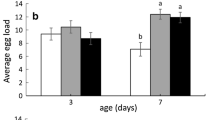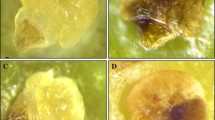Summary
Gall-inhabiting individuals of the aphidPemphigus obesinymphae act as defenders, protecting other colony members against attack by dipteran and neuropteran larvae that are the primary predators of this species. As first instar nymphs, the progeny of the fundatrix patrol surfaces of galls and adjoining leaves. These first instar nymphs attack potential predators by mounting and grasping them and inserting their stylets. This defensive behavior, which is not exhibited by nymphs in later instars, appears to be effective in reducing predation. The fundatrix typically produces defenders throughout the extended gall-inhabiting phase, and her progeny delay development beyond the defensive first instar stage. By August, galls contain an average of 101 defenders. Early death of the fundatrix reduces the number of defenders in the gall and advances maturation of defenders into winged migrants, which otherwise mature in September and October. InPemphigus, defensive behavior by first instar nymphs appears to have evolved in the context of several types of derived life cycle, each involving an extended gall-inhabiting phase.
Similar content being viewed by others
References
Alexander, R. D., K. M. Noonan and B. J. Crespi, 1991. The evolution of eusociality. In:The Biology of the Naked Mole Rat (P. W. Sherman, J. J. M. Jarvis and R. D. Alexander, Eds.), Princeton University Press, Princeton, New Jersey, pp. 3–44.
Aoki, S., 1975. Descriptions of the Japanese species ofPemphigus and its allied genera (Homoptera: Aphidoidea).Ins. Mats. N. S. 5:1–63.
Aoki, S., 1977.Colophina clematis (Homoptera: Pemphigidae), an aphid species with ‘oldiers”.Kontyu 45:276–282
Aoki, S., 1979. Dimorphic first instar larvae produced by the fundatrix ofPachypappa marsupialis (Homoptera: Aphidoidea).Kontyu 47:390–398.
Aoki, S., 1980. Occurrence of a simple labor in a gall aphid.Pemphigus dorocola (Homoptera: Pemphigidae).Kontyu 48:71–73.
Aoki, S., 1987. Evolution of sterile soldiers in aphids. In:Animal Societies: Theories and facts (Y. Itô, J. L. Brown and J. Kikkawa, Eds.), JSSP, Tokyo, pp. 53–65.
Aoki, S. and U. Kurosu, 1986. Soldier of a European gall aphid,Pemphigus spyrothecae (Homoptera: Aphidoidea): Why do they molt?J. Ethol. 4:97104.
Aoki, S. and U. Kurosu, 1988. Secondary moneocy of a North American gall aphid,Pemphigus monophagus (Homoptera: Aphidoidea).Kontyu 56:394401.
Aoki, S. and U. Kurosu, 1989. Can root generationsof Pemphigus (Homoptera: Aphidoidea) grow in the poplar gall?Jpn. J. Ent. 57:205–209.
Aoki, S. and U. Kurosu, 1991. An aptera and its abnormal offspring found in a gall ofPemphigus dorocola (Homoptera: Aphidoidea).Jpn. J. Ent. 59:555–563.
Benton, T. G. and W. A. Foster, 1992. Altruistic housekeeping in an aphid.Proc. R. Soc. Lond. B 247:199–202.
Faith, D. P., 1979. Strategies of gall formation inPemphigus aphids.J. New york Entomol. Soc. 87:21–37.
Foster, W. A., 1990. Experimental evidence for effective and altruistic olony defence against natural predators by soldiers of the gall-forming aphidPemphigus spyrothecae (Hemiptera: Pemphigidae).Behav. Ecol. Sociobiol. 27:421–430.
Itô, Y., 1989. The evolutionary biology of sterile soldiers in aphids.Trends in Ecology and Evolutionary Biology 4:69–73.
Itô, Y. and Hattori, 1982. A kleptoparasitic moth,Nola innocua, attacking aphid galls.Ecol. Entomol. 7:475–478.
Rhomberg, L., 1980. Causes of life history differences between the morphs ofPemphigus populitransversus.J. New York Entomol. Soc. 88:106–112.
Senner, J. W. and R. R. Sokal, 1974. Analysis of dimorphism in natural populations with consideration of methodological and epistemological problems.Syst. Zool. 23:363–386.
Setzer, R. W., 1980. Intergall migration in the aphid genusPemphigus.Ann. Entomol. Soc. Amer. 73:327–333.
Williams, A. G. and T. G. Whitham, 1986. Premature leaf abscission: an induced plant defense against gall aphids.Ecology 67:1619–1628.
Whitham, T. G., 1978. Habitat selection byPemphigus aphids in response to resource limitation and competition.Ecology 59:1164–1176.
Wilson, E. O., 1953. The origin and evolution of polymorphism in ants.Quart. Rev. Biol. 28:136–156.




